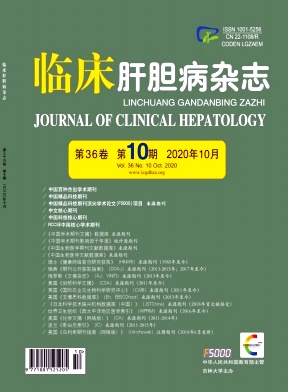|
[1] BRAY F,FERLAY J,SOERJOMATARAM I,et al. Global cancer statistics 2018:GLOBOCAN estimates of incidence and mortality worldwide for 36 cancers in 185 countries[J]. CA Cancer J Clin,2018,68(6):394-424.
|
|
[2] CHEN W,ZHENG R,BAADE PD,et al. Cancer statistics in China,2015[J]. CA Cancer J Clin,2016,66(2):115-132.
|
|
[3] KUDO M,IZUMI N,ICHIDA T,et al. Report of the 19th follow-up survey of primary liver cancer in Japan[J]. Hepatol Res,2016,46(5):372-390.
|
|
[4] DONG LQ,PENG LH,MA LJ,et al. Heterogeneous immunogenomic features and distinct escape mechanisms in multifocal hepatocellular carcinoma[J]. J Hepatol,2020,72(5):896-908.
|
|
[5] XIE DY,FAN HK,REN ZG,et al. Identifying clonal origin of multifocal hepatocellular carcinoma and its clinical implications[J]. Clin Transl Gastroenterol,2019,10(2):e00006.
|
|
[6] RAMACCIATO G,MERCANTINI P,PETRUCCIANI N,et al.Does surgical resection have a role in the treatment of large or multinodular hepatocellular carcinoma?[J]. Am Surg,2010,76(11):1189-1197.
|
|
[7] BRUIX J,REIG M,SHERMAN M. Evidence-based diagnosis,staging,and treatment of patients with hepatocellular carcinoma[J]. Gastroenterology,2016,150(4):835-853.
|
|
[8] BRUIX J,TAKAYAMA T,MAZZAFERRO V,et al. Adjuvant sorafenib for hepatocellular carcinoma after resection or ablation(STORM):A phase 3,randomised,double-blind,placebo-controlled trial[J]. Lancet Oncol,2015,16(13):1344-1354.
|
|
[9] WHITE R,NAIR RL,BRADLEY RH. Theorizing the benefits and costs of adaptive cultures for development[J]. Am Psychol,2018,73(6):727-739.
|
|
[10] KUDO M,FINN RS,QIN S,et al. Lenvatinib versus sorafenib in first-line treatment of patients with unresectable hepatocellular carcinoma:A randomised phase 3 non-inferiority trial[J]. Lancet,2018,391(10126):1163-1173.
|
|
[11] SPINZI G,PAGGI S. Sorafenib in advanced hepatocellular carcinoma[J]. N Engl J Med,2008,359(23):2497-2498;author reply 2498-2499.
|
|
[12] CROCENZI TS,EL-KHOUEIRY AB,YAU TC,et al. Nivolumab(nivo)in sorafenib(sor)-naive and-experienced pts with advanced hepatocellular carcinoma(HCC):CheckMate040 study[J]. 2017,35(15 suppl):4013.
|
|
[13] EL-KHOUEIRY AB,SANGRO B,YAU T,et al. Nivolumab in patients with advanced hepatocellular carcinoma(CheckMate040):an open-label,non-comparative,phase 1/2 dose escalation and expansion trial[J]. Lancet, 2017, 389(10088):2492-2502.
|
|
[14] ZHU AX,FINN RS,EDELINE J,et al. Pembrolizumab in patients with advanced hepatocellular carcinoma previously treated with sorafenib(KEYNOTE-224):A non-randomised,open-label phase 2 trial[J]. Lancet Oncol,2018,19(7):940-952.
|
|
[15] KELLEY RK. Adjuvant sorafenib for liver cancer:Wrong stage,wrong dose[J]. Lancet Oncol,2015,16(13):1279-1281.
|
|
[16] HUANG A,ZHAO X,YANG XR,et al. Circumventing intratumoral heterogeneity to identify potential therapeutic targets in hepatocellular carcinoma[J]. J Hepatol,2017,67(2):293-301.
|
|
[17] LIN DC,MAYAKONDA A,DINH HQ,et al. Genomic and epigenomic heterogeneity of hepatocellular carcinoma[J]. Cancer Res,2017,77(9):2255-2265.
|
|
[18] TORRECILLA S,SIA D,HARRINGTON AN,et al. Trunk mutational events present minimal intra-and inter-tumoral heterogeneity in hepatocellular carcinoma[J]. J Hepatol,2017,67(6):1222-1231.
|
|
[19] FEO F,PASCALE RM. Multifocal hepatocellular carcinoma:Intrahepatic metastasis or multicentric carcinogenesis?[J].Ann Transl Med,2015,3(1):4.
|
|
[20] GAO Q,WANG ZC,DUAN M,et al. Cell culture system for analysis of genetic heterogeneity within hepatocellular carcinomas and response to pharmacologic agents[J]. Gastroenterology,2017,152(1):232-242. e4.
|
|
[21] FURUTA M,UENO M,FUJIMOTO A,et al. Whole genome sequencing discriminates hepatocellular carcinoma with intrahepatic metastasis from multi-centric tumors[J]. J Hepatol,2017,66(2):363-373.
|
|
[22] ZHAI W,LIM TK,ZHANG T,et al. The spatial organization of intra-tumour heterogeneity and evolutionary trajectories of metastases in hepatocellular carcinoma[J]. Nat Commun,2017,8:4565.
|
|
[23] XU LX,HE MH,DAI ZH,et al. Genomic and transcriptional heterogeneity of multifocal hepatocellular carcinoma[J]. Ann Oncol,2019,30(6):990-997.
|
|
[24] HUANG M,HE M,GUO Y,et al. The influence of immune heterogeneity on the effectiveness of immune checkpoint inhibitors in multifocal hepatocellular carcinomas[J]. Clin Cancer Res,2020,26(18):4947-4957.
|
|
[25] SIA D,JIAO Y,MARTINEZ-QUETGLAS I,et al. Identification of an immune-specific class of hepatocellular carcinoma,based on molecular features[J]. Gastroenterology,2017,153(3):812-826.
|
|
[26] DUAN M,HAO J,CUI S,et al. Diverse modes of clonal evolution in HBV-related hepatocellular carcinoma revealed by single-cell genome sequencing[J]. Cell Res,2018,28(3):359-373.
|
|
[27] BAFFY G. Decoding multifocal hepatocellular carcinoma:An opportune pursuit[J]. Hepatobiliary Surg Nutr,2015,4(3):206-210.
|
|
[28] MORIMOTO O,NAGANO H,SAKON M,et al. Diagnosis of intrahepatic metastasis and multicentric carcinogenesis by microsatellite loss of heterozygosity in patients with multiple and recurrent hepatocellular carcinomas[J]. J Hepatol,2003,39(2):215-221.
|
|
[29] YAMAMOTO T,KAJINO K,KUDO M,et al. Determination of the clonal origin of multiple human hepatocellular carcinomas by cloning and polymerase chain reaction of the integrated hepatitis B virus DNA[J]. Hepatology, 1999, 29(5):1446-1452.
|
|
[30] KAWAI S,IMAZEKI F,YOKOSUKA O,et al. Clonality in hepatocellular carcinoma:Analysis of methylation pattern of polymorphic X-chromosome-linked phosphoglycerate kinase gene in females[J]. Hepatology,1995,22(1):112-117.
|
|
[31] MIAO R,LUO H,ZHOU H,et al. Identification of prognostic biomarkers in hepatitis B virus-related hepatocellular carcinoma and stratification by integrative multi-omics analysis[J]. J Hepatol,2014,61(4):840-849.
|
|
[32] ZHANG Q,LOU Y,YANG J,et al. Integrated multiomic analysis reveals comprehensive tumour heterogeneity and novel immunophenotypic classification in hepatocellular carcinomas[J]. Gut,2019,68(11):2019-2031.
|
|
[33] XUE R,LI R,GUO H,et al. Variable intra-tumor genomic heterogeneity of multiple lesions in patients with hepatocellular carcinoma[J]. Gastroenterology,2016,150(4):998-1008.
|
|
[34] CHEN XP,LONG X,JIA WL,et al. Viral integration drives multifocal HCC during the occult HBV infection[J]. J Exp Clin Cancer Res,2019,38(1):261.
|
|
[35] AMIROUCHENE-ANGELOZZI N,SWANTON C,BARDELLI A. Tumor evolution as a therapeutic target[J]. Cancer Discov,2017.[Online ahead of print]
|
|
[36] FALTAS BM,PRANDI D,TAGAWA ST,et al. Clonal evolution of chemotherapy-resistant urothelial carcinoma[J]. Nat Genet,2016,48(12):1490-1499.
|
|
[37] WANG J,CAZZATO E,LADEWIG E,et al. Clonal evolution of glioblastoma under therapy[J]. Nat Genet,2016,48(7):768-776.
|
|
[38] LEE JK,WANG J,SA JK,et al. Spatiotemporal genomic architecture informs precision oncology in glioblastoma[J]. Nat Genet,2017,49(4):594-599.
|
|
[39] SCHULZE K,NAULT JC,VILLANUEVA A. Genetic profiling of hepatocellular carcinoma using next-generation sequencing[J]. J Hepatol,2016,65(5):1031-1042.
|
|
[40] Cancer Genome Atlas Research Network. Comprehensive and integrative genomic characterization of hepatocellular carcinoma[J]. Cell,2017,169(7):1327-1341. e23.
|
|
[41] DING X,HE M,CHAN A,et al. Genomic and epigenomic features of primary and recurrent hepatocellular carcinomas[J]. Gastroenterology,2020.[Online ahead of print]
|














 DownLoad:
DownLoad: